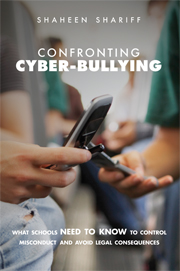 Confronting Cyber-Bullying
Confronting Cyber-Bullying Book contents
- Frontmatter
- Contents
- Figures
- Tables
- Preface
- Acknowledgments
- 1 Cyber Misconduct: Who Is Lord of the Bullies?
- 2 Profile of Traditional and Cyber-Bullying
- 3 Cyber Libel or Criminal Harassment: When Do Kids Cross the Line?
- 4 Student Free Expression: Do the Schoolhouse Gates Extend to Cyberspace?
- 5 Fostering Positive School Environments: Physical and Virtual
- 6 Censoring Cyberspace: Can Kids Be Controlled?
- 7 The Tragedy of the Commons: Lessons for Cyberspace?
- 8 Cyber Collaboration: Models for Critical Legal Pluralism in Teacher Education Programs
- Notes
- Cases
- Index
- References
5 - Fostering Positive School Environments: Physical and Virtual
Published online by Cambridge University Press: 02 July 2009
- Frontmatter
- Contents
- Figures
- Tables
- Preface
- Acknowledgments
- 1 Cyber Misconduct: Who Is Lord of the Bullies?
- 2 Profile of Traditional and Cyber-Bullying
- 3 Cyber Libel or Criminal Harassment: When Do Kids Cross the Line?
- 4 Student Free Expression: Do the Schoolhouse Gates Extend to Cyberspace?
- 5 Fostering Positive School Environments: Physical and Virtual
- 6 Censoring Cyberspace: Can Kids Be Controlled?
- 7 The Tragedy of the Commons: Lessons for Cyberspace?
- 8 Cyber Collaboration: Models for Critical Legal Pluralism in Teacher Education Programs
- Notes
- Cases
- Index
- References
Summary
You don't know me …
But I know you …
I've been watching you at school …
And if you don't want to die … I'd sleep with one eye open
Down on your knees, bitch!
Raveger, Raveger
(Shariff, 2001)INTRODUCTION
My first experience with cyber-bullying began with an e-mail from “Raveger, Raveger.” The e-mail was sent to our daughter Shelina (pseudonym), when she was about fifteen years old, in Grade 11 at a high school in British Columbia, Canada. We came home one afternoon and found her pale and frightened, which was unusual for this normally feisty teenager. She handed us a printout of the e-mail that is quoted above. As a parent, I was concerned about Shelina's safety. Was this a pedophile? Was it an adult at school? If a student was involved, did he know her walking route home from school? The reference to watching her at school brought the threat into the realm of the physical school environment, despite the fact that it was sent over the weekend from a home computer. School police liaison officers were unsuccessful in tracing the e-mail, and our efforts to trace the source of the e-mail through the Internet service provider (ISP) met a brick wall. First there was no response to our calls and e-mails. When eventually contacted, an ISP manager explained that he could not shut down the e-mail source to protect the client's free expression rights.
- Type
- Chapter
- Information
- Confronting Cyber-BullyingWhat Schools Need to Know to Control Misconduct and Avoid Legal Consequences, pp. 127 - 158Publisher: Cambridge University PressPrint publication year: 2009
